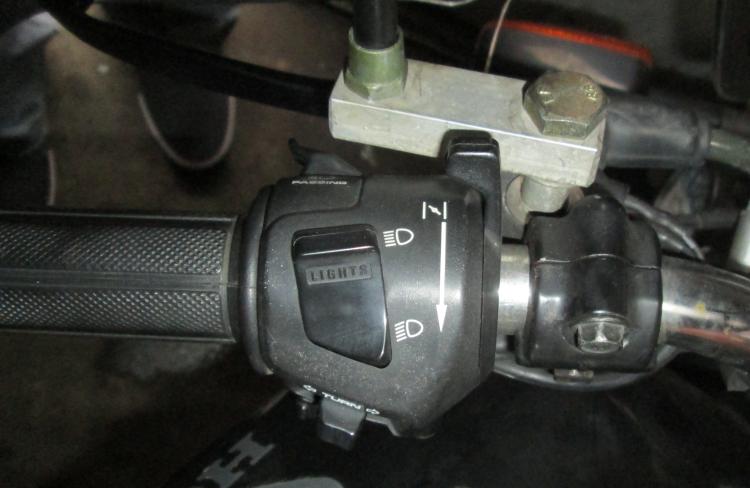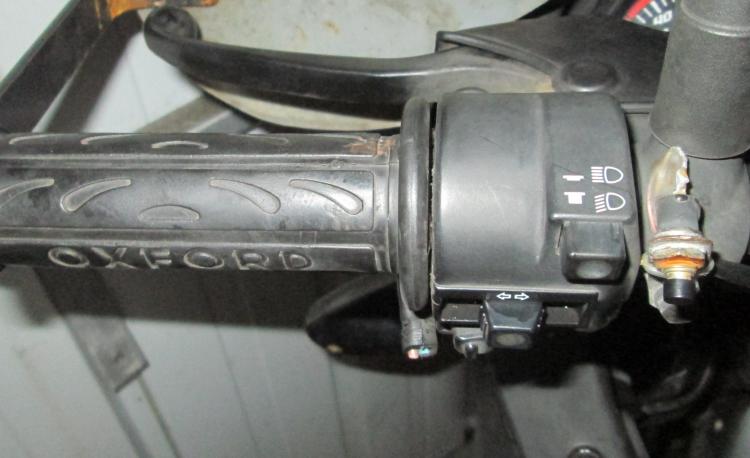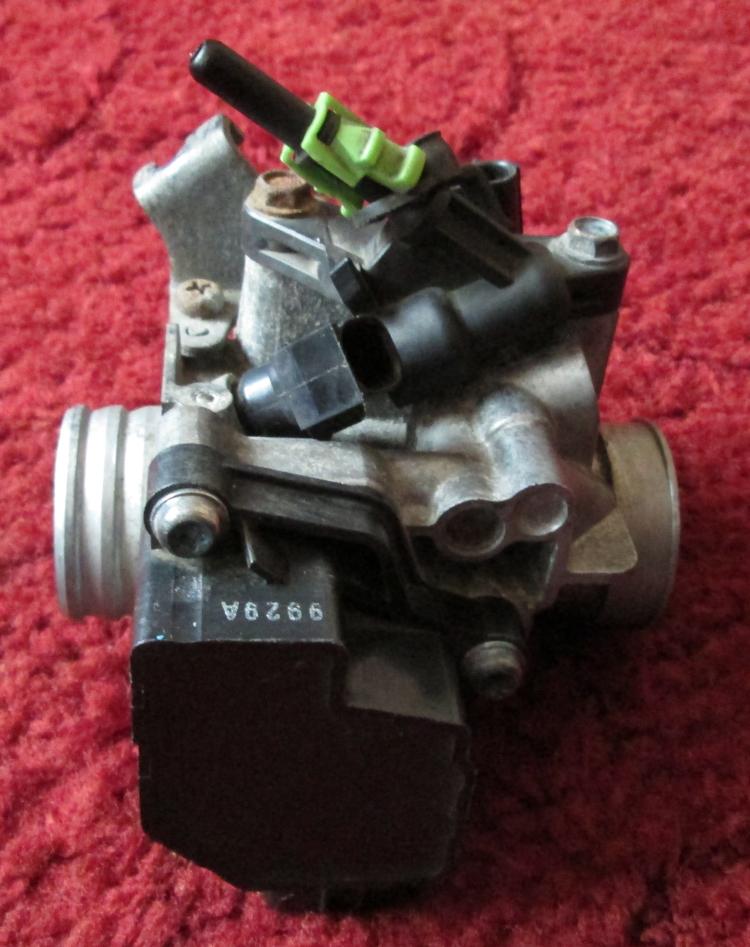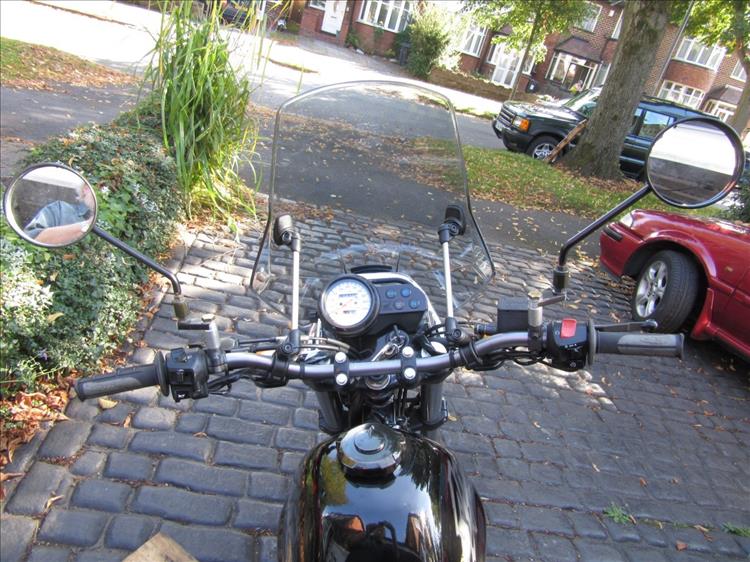Home
Ren's Biking Blog
Different Chokes
Let us say we have 2 motorcycles of exactly the same model, the same age and similar mileage. In this instance I'll suggest a pair of CLR 125s because I know these are carburetted, both have about 7,000 miles on the clock and both are '03 registered. Both have been sat in the same garage and both were last used yesterday. Start 'em up.
One will need full choke and refuse to tick over until it's been on the road for 5 minutes. The other won't need any choke no matter how cold or damp it is. Dagnammit!
 To choke or not to choke? That is the question.
To choke or not to choke? That is the question.
Most motorcycles have starting instructions in the owner's handbook. Typically it would suggest full choke on cold days for a few minutes then close the choke. And yet in my experience every bike has its own individual quirks and foibles. My SLR 650 required choke even on a warm day if it had been stood for more than 5 minutes yet the NTV 600 Revere never once wanted choke but did like a little blip of the throttle to wake it up. The Fazer 600 was an indecisive bugger that would keep me guessing from month to month.
Why? I don't actually know, but I can take a guess. No two motorcycles come out of the factory exactly the same nor do they experience the same usage. One may have been run in really carefully while the other bike was thrashed from the first mile. One may have been regularly professionally serviced while the other may never have seen a spanner. Storage conditions may differ. One may be used for short commutes while the other is only used on warm dry weekends. No matter how similar motorcycles may be in age and mileage they all experience different lives.
This is all very well and good, a mechanically sympathetic owner soon works out how to start their own machine after a few weeks. But what of these modern machines where there is no choke?
 ARGH!!! Where's me choke lever gone?
ARGH!!! Where's me choke lever gone?
Deep inside the injection system of an injected motorcycle lies a program to start the bike. The computer, once the ignition is switched on, will at least know the temperature of the engine if not the temperature of the air. The computer is pre-programmed with a set of instructions for starting in the cold. I would guess that involves putting more fuel in then possibly opening the idle air control valve a little. That's great, that's the equivalent of putting on the choke. But...but what if this engine is one of those that rarely needs choke?
High end motorcycles may have enough computing power to apply a learning algorithm. This system keeps a record of settings to start the engine in various conditions and some means of recording how well the engine started. This database is updated, manipulated and adjusted each time the motor starts to ensure the best possible settings for a wide variety of temperatures. Heck these trick machines may even know about humidity, atmospheric pressure and how long it is since the engine was last running. All this data means the computer is well ahead of the game. Bear in mind though, if you replace the computer with one from another motorcycle the learning curve has to start all over again, the bike may not even start at all.
But my Honda CBF 125? I very very much doubt that has such an advanced computer. There will likely be a simple set of instructions to start the engine dependant only on engine oil temperature alone - there is only an engine oil temperature sensor. And yet it works time and time and time again. It starts and ticks over happily be it sub zero and icy, cold wet and windy or on those rare occasions it is warm and dry. How does it do this?
Witchcraft...magic and wizardry. Beelzebub bring forth fire from Hades to ignite the fuel.
 Magic...CBF125 injection...witchdraft and wizardy is within.
Magic...CBF125 injection...witchdraft and wizardy is within.
Reader's Comments
Bob said :-
Not magic - pressurised fuel lines.
The biggest difference between carbs and FI is that in the FI the fuel system is pressurised. On a cold start you need the engine to get up a vacuum to drag the cold dense fuel up from the float bowl, possibly through jets which have water condensation in them.
But if you have FI, the fuel is under pressure, the injector opens and the fuel can't wait to shoot straight into the waiting engine. It's like every start is a hot start.
BTW that's why I've found on older bikes that the ones with the plunger (or "two stroke style") enrichmener are a damn sight easier to start than the ones with the car style choke butterfly.
22/02/2016 13:34:46 UTC
Ian Soady said :-
I like the home-made mirror extenders - just like mine:
 22/02/2016 15:05:13 UTC
22/02/2016 15:05:13 UTC
Ian Soady said :-
"BTW that's why I've found on older bikes that the ones with the plunger (or "two stroke style") enrichmener are a damn sight easier to start than the ones with the car style choke butterfly."
Yes, effectively that's a separate tiny carb on the side. The key to using them is to make sure you give it no throttle when starting as otherwise air will follow the path of least resistance through the main carb.
What's wrong with the old Amal tickler that's what I want to know?
22/02/2016 15:07:49 UTC
Ren - The Ed said :-
Bob - Is that so? I thought even with an FI engine the computer would need to pump more fuel in for a cold start? Even so, yes the FI is squirting juice in with quite some force as opposed to a carb which might lob some in if the engine can be arsed sucking hard enough.
As for the butterfly style choke - I can't say I've noticed. My Benly had a butterfly and that started just fine. It's certainly easier to understand as a novice. At first the plunger style looks like dark magic but like Ian says if you spend the time to work it out it actually opens a small "mini carb" through the side of the regular carb body.
As for the mirror extenders Ian I have to thank Stephen Latchford for mine. You might recognise that name from some of the restoration projects on here. It makes me sick you folks that turn out nice, well made and well thought out bits of metal, not like my own bodges. Pffft! And that SLR 650 is far too clean.
22/02/2016 16:48:37 UTC
Bob said :-
You're right, FI systems do have a cold start routine where they shoot more fuel in from cold. My Versys would start up and tick over at ~2K for 30 or 40 seconds before settling down to normal. I had an early R1100GS which had FI and a manual choke! They called it a fast idle lever or something like that. It was needed.
I've had a few GS750s which had the butterfly chokes and they were shocking, whereas I've never had plunger choke bike that suffered cold start problems.
Was it the CD200? I had a metallic blue one, with the chrome trims on the side panels. It was 6V but had electric start (and kick), Me and SWMBO went everywhere on that bike.
25/02/2016 09:31:28 UTC
Ren - The Ed said :-
Hi Bob. The Benly was indeed the CD200. I despatched on it for quite a while until it finally nipped up its crank. It was a GREAT bike - cheap to run, reliable and with altogether shocking handling. I guess the worn out suspension never helped but the frame acted as a third hinge I'm sure. Mine was a later model with 12v electrics that did actually work.
The CBF 125 with FI raises the tickover automatically for a short while. I suspect the computer monitors the oil temperature - that's the only temperature sensor on this simple system. When it reaches a certain value it will retard the idle to the normal value. As to whether or not the computer actually increases fuel mixture I have no way of knowing. I have always been told that this is the case but I cannot confirm this.
25/02/2016 17:21:52 UTC
Bob said :-
Well, I don't think the CBF has got fly by wire throttle control so the only way the FI could raise the tickover is by putting more fuel in.
26/02/2016 10:57:14 UTC
Ren - The Ed said :-
The CBF 125 is not fly by wire but it does have an idle circuit. Within this is a stepper motor controlled by the computer. This is called the "Air Idle Control Valve". It alters the amount of air allowed through the idle circuit and the computer can easily control the amount of fuel going in via the injector. As such the computer manages the tickover, there is not throttle stop screw.
26/02/2016 11:29:09 UTC
Bob said :-
Oh right, that's the same as my X Country.
I was interested to see that the Versys didn't have an AIC Valve but did have a throttle stop screw - it worked perfectly and it also did the fast idle on cold start thing.
Perhaps it is voodoo afterall?
26/02/2016 22:11:26 UTC
Ren - The Ed said :-
I suppose just pumping in a little more fuel would raise the tickover? No...no it's voodoo, it's wizardy and witchery, it's black magic and the dark arts. Fuel Injection systems are in league with the dark side and powered by trolls and orcs.
27/02/2016 07:35:37 UTC
Ian Soady said :-
On the other hand.....
It's so much easier to adjust the air/fuel ratio with a laptop, some free software and a cable than by mucking about with jests, slides & needles (much though I love the latter).
28/02/2016 10:29:24 UTC
Ren - The Ed said :-
Maybe that's the case with a trick powercommander but I don't think they do a powercommander for my little CBF 125. There's....there's probably not much call for them...
I do agree though, the notion of just plugging in and tweaking a few digital sliders is a hell of a lot simpler than guessing with jets and sliders.
28/02/2016 10:57:26 UTC
Ian Soady said :-
A quick google turned up this:
http://world.honda.com/motorcycle-technology/pgm-fi/p4.html
which looks quite interesting. Can't see any mention of an OBDII or similar connector so maybe not possible to tweak the settings easily.
It does say there are two kinds of map and that there is feedback from an O2 sensor so one thing that might have an interesting effect is to fit an O2 sensor eliminator (essentially just a resistor).
OTOH it will be quite easy to brick the ECU......
28/02/2016 14:28:30 UTC
Ren - The Ed said :-
Mine is obviously an earlier design as the ECU is separately mounted but otherwise most of this looks similar.
As for bricking the ECU...if it ain't broke I sure as hell ain't gonna try and fix it. I reckon you could only raise the power by 1 or 2 bhp. If I want more power I'll get a bigger bike!
28/02/2016 20:19:15 UTC
Name
Comment
Add a RELEVANT link (not required)
Upload an image (not required) -
Uploading...
Home
Ren's Biking Blog